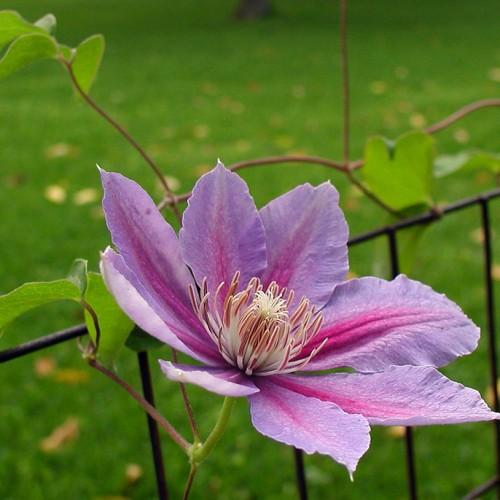
clematis
Clematis 'Fireworks'
Cycle:
Perennial
Watering:
Average
Hardiness Zone:
4 - 8
Flowers:
Flowers
Sun:
Full sun,part shade
Leaf:
Yes
Growth Rate:
High
Maintenance:
Low
watering
For best results, clematis should be watered deeply and regularly. Water newly planted clematis about once a week for the first season. Once established, it should be watered during dry spells, unless there is a period of consistent rain. With established plants, a deep watering once a week should keep them looking lively and lush, depending on the temperatures and rainfall. Water at the base of the plants, avoiding the foliage and leaves, as to prevent the plant from getting mildew or fungal diseases.
sunlight
When it comes to sunlight, Clematis 'Fireworks' thrives in full sun to partial shade. During the hottest summer days, some afternoon shade may be necessary to protect the plant from heat stress. For optimal health, the clematis should receive at least 6 hours of direct sunlight each day. In the winter months, however, the amount of light can be reduced to 4-5 hours per day. This will help ensure that the clematis is able to enter its blooming dormant state.
pruning
Prune clematis (Clematis 'Fireworks') annually in late winter or early spring. Pruning for this clematis should not go into summer as this can discourage blooming. Prune 1-third to 1-half of the oldest stems each year, cutting just above a pair of healthy buds. Stems should be cut no higher than 30 cm from the ground. This plant does not require significant pruning, but dead head wilted blooms to avoid self-seeding.
Season
Hardiness Map
FAQ
Can Clematis plants grow in pots?
Yes, Clematis plants can definitely be grown in pots. When planting a Clematis in a pot make sure to use a larger size pot with drainage holes and fill it with a mix of well-draining potting soil and compost. Ensure to keep the root area cool and the pot in a sunny location while providing regular water and fertilization. Check the plant almost daily to make sure it is not becoming too dry. Clematis can do well in a pot and with the right care and conditions, they will thrive.
Are Clematis plants self-pollinating?
No, clematis plants are not self-pollinating. Clematis plants need pollinators such as bees, butterflies, moths and other insects to transfer pollen from the male anthers to the female stigma of the flower in order to produce viable seed. Pollination must also occur within relatively close proximity of the same species in order to create viable hybrid plants.
Can Clematis plants be grown as a houseplant?
Yes, Clematis plants can be grown as a houseplant. It is best to grow them in a pot with full sun and a soil that is rich in organic material and retains moisture. When potting the plant, place a stake or trellis next to the pot so that the vine can climb when it begins to grow. Be sure to water your Clematis plant regularly to keep it healthy and growing. Additionally, keep an eye out for pests and treat with natural insecticides as necessary.
Could Clematis plants survive in a colder climate?
Yes, Clematis plants can survive in colder climates with proper preparation. If planted in the fall, proper mulching should be done to protect the roots from cold temperatures. If planted in the spring, they should be watered frequently to help them adjust to the cooler temperatures more quickly. If temperatures drop below -20°C ( -4°F), additional measures may need to be taken such as the application of protective wraps and thermal insulation. Additionally, plants in exposed areas should be protected from the wind to prevent excessive dehydration. With the right measures in place, Clematis plants can easily survive in colder climates.
Could Clematis plants be grown in a greenhouse?
Yes, clematis plants can be grown in a greenhouse. Due to their vine-like growth habit and tropical native origins, clematis plants thrive in the moist and warm environment of a greenhouse. Clematis are generally grown from cuttings or from dividing existing plants, and benefit from regular pruning and fertilizing. They will also enjoy the indirect light of a greenhouse and the protection from strong winds and temperatures that the humidity and contained environment provides.
